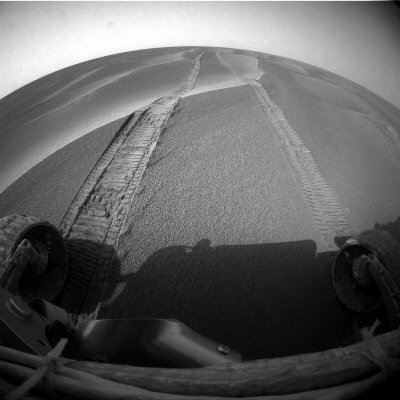Sat, Aug 30, 2008
Erstwhile Rover Back On Flat Ground
NASA announced Friday its Mars Exploration Rover Opportunity has
climbed out of the large crater that it had been examining from the
inside since last September.

"The rover is back on flat ground," an engineer who drives it,
Paolo Bellutta of NASA's Jet Propulsion Laboratory, announced to
the mission's international team of scientists and engineers.
Opportunity used its own entry tracks from nearly a year ago as
the path for a drive of 6.8 meters (22 feet) bringing the rover out
over the top of the inner slope and through a sand ripple at the
lip of Victoria Crater. The exit drive, conducted late Thursday,
completed a series of drives covering 50 meters (164 feet) since
the rover team decided about a month ago that it had completed its
scientific investigations inside the crater.

"We're headed to the next adventure out on the plains of
Meridiani," said JPL's John Callas, project manager for Opportunity
and its twin Mars rover, Spirit. "We safely got into the crater, we
completed our exploration there, and we safely got out. We were
concerned that any wheel failure on our aging rover could have left
us trapped inside the crater."
The Opportunity mission has focused on Victoria Crater for more
than half of the 55 months since the rover landed in the Meridiani
Planum region of equatorial Mars. The crater spans about 800 meters
(half a mile) in diameter and reveals rock layers that hold clues
to environmental conditions of the area through an extended period
when the rocks were formed and altered.
The team selected Victoria as the next major destination after
Opportunity exited smaller Endurance Crater in late 2004. The
ensuing 22-month traverse to Victoria included stopping for studies
along the route and escaping from a sand trap. The rover first
reached the rim of Victoria in September 2007. For nearly a year,
it then explored partway around the rim, checking for the best
entry route and examining from above the rock layers exposed in a
series of promontories that punctuate the crater perimeter.

Now that Opportunity has finished exploring Victoria Crater and
returned to the surrounding plain, the rover team plans to use
tools on the robotic arm in coming months to examine an assortment
of cobbles -- rocks about fist-size and larger -- that may have
been thrown from impacts that dug craters too distant for
Opportunity to reach.
More News
He Attempted To Restart The Engine Three Times. On The Third Restart Attempt, He Noticed That Flames Were Coming Out From The Right Wing Near The Fuel Cap Analysis: The pilot repor>[...]
Make Sure You NEVER Miss A New Story From Aero-News Network Do you ever feel like you never see posts from a certain person or page on Facebook or Instagram? Here’s how you c>[...]
From 2009 (YouTube Edition): Leading Air Show Performers Give Their Best Advice for Newcomers On December 6th through December 9th, the Paris Las Vegas Hotel hosted over 1,500 air >[...]
Aero Linx: NASA ASRS ASRS captures confidential reports, analyzes the resulting aviation safety data, and disseminates vital information to the aviation community. The ASRS is an i>[...]
“For our inaugural Pylon Racing Seminar in Roswell, we were thrilled to certify 60 pilots across our six closed-course pylon race classes. Not only did this year’s PRS >[...]
 NTSB Final Report: Rutan Long-EZ
NTSB Final Report: Rutan Long-EZ ANN FAQ: Turn On Post Notifications
ANN FAQ: Turn On Post Notifications Classic Aero-TV: ICAS Perspectives - Advice for New Air Show Performers
Classic Aero-TV: ICAS Perspectives - Advice for New Air Show Performers ANN's Daily Aero-Linx (06.28.25)
ANN's Daily Aero-Linx (06.28.25) Aero-News: Quote of the Day (06.28.25)
Aero-News: Quote of the Day (06.28.25)




